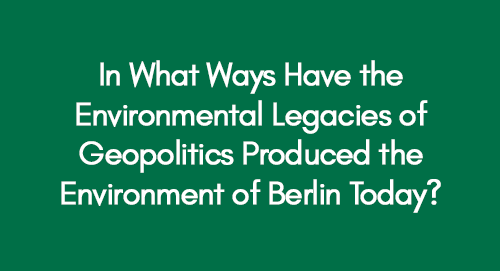
Challenges Entrepreneurs Face While Implementing Advanced Biomedical Technology in Healthcare: The Case Study of UK
June 1, 2022
How Does the Use of Psychodynamic Therapy in Comparison to Medication Help in Treating Depression in Teenagers? A PICO analysis
June 2, 2022Introduction
The following discussion provides comprehensive evidence regarding how the environmental legacies of geopolitics have impacted Berlin's environment. As stated in the study of O'Lear and Dalby (2015), the environment plays an important part in the world's geopolitics. In the current world, climate change is an emergent issue that is a concern for all. Agreed to Oberthür (2016), many countries are responsible for contributing to harm to the environment and causing global warming. Each country around the world is required to do its part in tackling the climate change issue by monitoring the environment. Similarly, as Jacobs (2016) added, Germany tries to do its part in looking after the environment and taking action to benefit it. Germany has adopted many policies that minimize its contribution to global warming. The emission of CO2 gas into the atmosphere was one area the policies targeted.
Furthermore, as per Ringel et al. (2016), Germany also aims to increase green, and many German cities, particularly Berlin, have planted many trees and plants to tackle the climate change issue. Thierfelder and Kabisch (2016) stated that Berlin, Germany's capital city, had failed to adhere to the World Health Organisation (WHO) standards. In response to the issue, the city has made a positive stance toward tackling the environmental issue. According to Visit Berlin (2020), the city has an ecological zone where the emission of harmful greenhouse gases is minimum. In this zone, only environmentally-friendly vehicles are allowed that do minimal damage to the environment. This study will discuss, analyse, and evaluate Germany's environmental legacy and capital. The study will look at the current environmental condition of Berlin and the policies taken by the government to tackle the climate change issue. The study will further glance at the past performance of Germany in its effort toward benefiting the environment.
The History of Geopolitics in Germany
Geopolitics is the concept of political actions, within the regional or international arena, for geographical motives, like expansion, access to key resources, etc. (Flint, 2016). The concept of geopolitics is prevalent throughout the world, throughout history, and in one form or another. In the case of Germany, the country shares a border with nine European countries and is located at the heart of Northern Europe (Smith, 2018). Nevertheless, it is essential to comprehend the history of Germany's geopolitics in order to understand the environmental legacies of geopolitics in Berlin. The geographical location of Germany, which entails border sharing with countries like France and Russia, has led to several political conflicts between the countries. On the other hand, Klinke (2018) has attributed the German concept of geopolitics to Carl Schmitt, who, in the 1930s, gave rise to the notion of ‘German Großraum’ or a greater German space. This was the first school of thought in German geopolitics that initiated expansion and encouraged Germany to break out of its centric position in Europe and ally with other world powers.
However, the advent of geographical motives within German politics was not brought about by Carl Schmitt in the 1930s; rather, it is much older than that. In the study of Reuber (2016), it is discussed that before World War I, Friedrich Ratzel incorporated population growth with territorial expansion. According to Ratzel’s teachings, Germany considered a world power, cannot bind itself to Europe forever and must expand its development to other parts of the world. This is the classical view of geopolitics and the expansionist mindset of several European states before World War I. Although Klinke (2018) adds that Ratzel’s concept did not die down after the WW1, it set the foundation for the eventual geopolitics employed by the Nazis in World War II. The worldview of Nazis was entangled between territorial might and concepts of spatiality. This gave the Nazi German view of ‘Lebensraum’, a vital living space (Giaccaria and Minca, 2016).
Conceptually, Lebensraum means adequate living space in terms of population, economy, military prowess, etc. This aspect is another part of Germany's environmental legacies of geopolitics. In Hitler’s Germany, the concept of Lebensraum was at the centre and formed the basis of German Geopolitics of the time. This led to the Germans' initiation of World War II and the inception of wars with Switzerland, Russia, England, France, etc. (Murphy, 2018). However, this is the historical perspective of geopolitics within Germany, the present state of geopolitics has abandoned the expansionist mindset. Friedman (2018) believes reunifying East and West Germany, followed by entrance into the European Union, brought major changes in Germany’s geopolitics. The study further adds that with the most recent election results, nationalism has been seen within the country. Therefore the future of geopolitics for Germany is more nationalist than expansionist, as seen in the past.
The environmental legacies of geopolitics
According to Keeling et al. (2018), environmental legacies of geopolitics are natural changes occurring because of the predecessor of unsettling human influences. The disturbing effect might result from changes in land use and land spread, fire system, water preoccupations, and presentations of synthetic hydrological and biogeochemical systems (Schmidt and Regner, 2018). Bleicher, David, and Rutjes (2018) stated that environmental legacies are significant because full comprehension of the elements of an ecological framework calls for acknowledgement of the drawn-out history and direction of changes. Numerous speculations have progressed concerning contrasts in the state of frameworks with and without environmental legacies of geopolitics (Sandlos and Keeling, 2016). According to Oxford Bibliographies (2020), an incorporated, process-arranged, verifiable perspective on natural, geomorphic, hydrological, and biogeochemical frameworks is required to investigate environmental legacies. It is because these legacies are related to the thought of the environment, and affectability on a landscape may uncover significant ramifications of the diligence of effects that may impact long-haul strategies for overseeing worldwide change.
Many countries' geopolitical legacy has affected their current climate and environmental policies. According to Husted and de Sousa-Filho (2017), the geopolitical aspect of the territory of a country affects the availability of resources and energy production, consequently affecting the country's environmental efforts. This applies to countries lacking energy and fuels and majorly exporting them from other countries (Rosenow, Kern, and Rogge, 2017). Newell (2019) has highlighted the green politics of the late 20th century as the biggest environmental legacies of geopolitics from the past. The legacy of green politics has proven well for sustainability purposes within industrialized countries such as Germany and Europe. The urban green space development within Berlin is also a part of many eco-friendly projects considered sustainable in the country.
Impact of geopolitics on the environment
The impact of the activities of people on the environment is viewed as a characteristic of human life in geopolitical ideas and practices (Flint, 2016). Researchers such as (Le Billon, 2017; Harper and Snowden 2017; Dalby, 2018) in their study discussed the possibility of impacting the world's environment due to the supposed geopolitical issues. Geological highlights, qualities, and divisions, in this sense, were viewed as timeless and consequently resistant to human modification in the past (Bjornerud, 2020). Geology was, in this manner, diminished to the job of essentially giving a regional platform on which the connections of states were formed (Greene, 2017). According to Power (2019), as a wide arrangement of compositions originally published in the mid1990s, basic geopolitics went under the boundaries of the order of geography. The initial research immediately multiplied into a broad exhibit of productions that assisted with forming the scholarly limits and directions of the new phenomenon of basic environmental effects of geopolitics. According to Okereke (2018), the key issue for basic geopolitics is to uncover its different outcomes on the environment and the dangers that the environment faces due to the geopolitical tug of war. When the effects of geopolitics on the environment are examined, the epistemological pathways are opened to decipher understandings about how geopolitics results in dangers to society and accounts for the drive of the interaction of humans (Ide, 2016).
According to the UNHCR report, millions of individuals have been displaced by geopolitical events such as wars in Syria, which have destroyed the entire region and its environment (O’Reilly, 2019). Geopolitical instability is presently dominating the shaping process of the current world. From the beginning of time, the environment has been a significant factor in shaping people and social practices. However, today it has become the most significant due to the non-eco-friendly processes carried out by the general public. The test at that point lies in making sense of the harmony between the geographical and environmental aspects. According to Dalby (2020), Geopolitics-on-Environment expects to give a one-stop speciality stage by conveying different talks and ideal models to tackle the heap ecological difficulties in the current situation and in the past. According to Steffen, Crutzen, and McNeill (2016), due to the rapidly spreading awareness about environmental issues, great emphasis is being put on the limits of human activities as the factors such as population growth and industrialization has caused ozone depletion and other environmental issues. Blue and Tadaki (2020) agreed and stated that Geopolitics is the key to limiting human activities disturbing the ecological balances and harming the environment. Bryant, Straker, and Wrigley (2019) stated that the geopolitical approaches of the government should contain concern for the environment, which can help rebuild.
Historical Perspective of Berlin’s Environment
The earliest concept of the environment within Berlin can be seen within the European wave of romanticism and its interpretation by the Germans. This aspect played a significant role in the environmental legacies of geopolitics in Berlin. Wimborne (2012) has highlighted that romanticism in Germany taught a subject’s level of consciousness regarding the value of the natural world. This view of nature was the first registered within German history, in which people were encouraged to become aware of nature. Contrarily, Stone (2014) has specified that the school of thought of romanticism was more concerned with a person’s initial alienation from the natural world and subsequent reconciliation. Although this viewpoint considers nature, it only deals with human’s relationship with nature rather than the protection or sustenance of nature. However, this point of view of nature, as given by the movement of romanticism, did not last very long. In the early 20th century, romanticism declined, and a general lack of priority was seen among Germans for environmental protection. According to the study by Keynes (2017), the fascist ideology that led to massive destruction in the country made economic reconstruction and industrialization a top priority, making environmental protection of the least importance for most Germans or people of Berlin.
A turning point in Germany’s environmental policy can be seen after 1969, with the form of the coalition government of SPD and FDP (Rootes, 2014). The study further explains that the strategies of an Environmental Program formed by this government are based on three principles, precaution, causation, and corporation. As a part of the environmental legacies of geopolitics, these three principles are seen as the basis of environmental policy within Berlin even today. Furthermore, in the 1980s, the civil society in Berlin became more vocal about environmental protection, with movements like ‘Waldsterben’ for forests and ‘Mutter Gegen Atomkraft’, which means mothers against nuclear power (Kirchhof and McConville, 2015). These gave rise to a cultural shift within the country as more people expressed their opinions on environmental sustainability problems. Lastly, at the end of the 20th century, the city of Berlin was planned and strategized as a safe and eco-friendly urban space with the help of stringent environmental laws and guidelines (Bendt, Barthel, and Colding, 2013).
The environment of Berlin in the 21st Century
With the advent of the 21st century, the biggest changes to environmental laws were brought about by the Grand Coalition headed by German Chancellor Angela Merkel (Mushaben, 2016). Under this coalition, environmental laws were amended, and a final product was presented in 2005, prioritising nature. Juerges and Newig (2015) add that in the recent environmental laws, Germany, as a member state of the EU, is majorly influenced by EU environmental codes. These include aspects of nuclear waste, waste reduction, fossil fuel reduction, air quality, and water quality. The European Union has assisted and strategized, in terms of environmental laws, in collaboration with German cities like Hamburg and Berlin. An example is the Green and Blue infrastructure currently employed by Berlin for biodiversity conservation, which is in line with the EU Biodiversity Strategy for 2020 (European Commission, 2019). The official report further specifies the funding of these practices, as the EU is responsible for a major chunk of financial resources for biodiversity conservation.
Berlin’s internal policy framework, Federal Nature Conservation Act, Marine Strategy Framework, and waste reduction are only a few of the legislative guidelines (European Commission, 2019). Each law has been framed in different years under different ministries, but all are encompassed under a single Environmental Law of Germany. However, in the ratings of environmentally friendly cities within Europe, Berlin scored 16 coming behind most big cities like Paris, London, Vienna, etc. (Lopez, Santamarina, and Nowakowski, 2020). This is a low score for a city like Berlin, with various sustainable and reduction guidelines for each sector and stage. DW (2020) has attributed this low score to Berlin’s major issue of air quality, which is worse than in most urban city centres. The study further specifies that the Air Quality Index in Berlin has failed so miserably that it contradicts EU laws and can even prove fatal for citizens of Berlin. On the other hand, Thierfelder and Kabisch (2016) believe that the sustainable laws enacted within the city of Berlin are more focused on visually pleasing projects, like open parks, urban spaces, etc. Regardless, the key issues of air and water quality are usually overlooked. However, much has been done to attain sustainability in Berlin to achieve net-zero carbon emissions within the city (Lopez, Santamarina, and Nowakowski, 2020). Despite such optimistic goals, Berlin still has a long way to go before becoming completely sustainable.
Urban green spaces in Berlin
Urban green spaces are profoundly important for the well-being and prosperity of urban occupants (Rahman and Zhang, 2018). Various studies, such as the study of (Eisenman, 2016; Haas, 2016; Baldwin and King, 2018), discuss the positive attributes of urban green spaces that benefit the urban populace, for example, by helping the urban atmosphere through temperature decreases or air filtration. Furthermore, Soga et al. (2016) demonstrated a quantifiable, positive psychological impact on urban inhabitants who have contact with nature, especially with elevated levels of biodiversity. According to McQuire (2017), the piece of urban space with a specific sum and quality available close to a private condition has been demonstrated to be inconceivably useful for older individuals. However, Wüstemann, Kalisch, and Kolbe (2017) argued that developing urban green spaces doesn’t benefit all of the urban population and is of no use to most of the urban population.
The city of Berlin in Germany is one case of a city with population growth in the world, while the other cases also include Tokyo, Delhi, and Shanghai (Frantzeskaki and Kabisch, 2016). According to Feng and Tan (2017), the biggest city in the nation, Berlin, is today home to 3.5 million occupants. The increment in population in the most recent decade remained parallel to an expansion in the size of neighbourhoods and a decrease in green spaces. Concerning urban green spaces, the city contains open green spaces and forest regions which cover over 30% of the city territory (Aronson et al., 2017). Pietrzyk-Kaszyńska, Czepkiewicz, and Kronenberg (2017) stated that these spaces incorporate parks, private yards, distributions, burial grounds, recreational regions, sports grounds, and street greenery. The biggest urban green space in Berlin is Tempelhof, the previous city air terminal, which is one example where changing the use of the area has made a huge green space in the city (Berlin.de, 2020). According to Bernt, Grell, and Holm (2013), albeit unique in Berlin, Tempelhof represents the experience of numerous old industrialized urban areas where downtown vehicle zones or huge waterfronts have been changed to other land engagements. There is also a need to spread this practice to other parts of Germany with fewer green spaces (Grunewald et al., 2017). Keeping the demographic change in Germany in mind, there is a need to focus on elderly individuals and their accessibility to green spaces when developing such spaces in urban areas. According to Kabisch and Haase (2014), the elderly population in Berlin mostly benefited from the high quality and good accessible urban green spaces of significant size.
Role of Environmental Legacies of Geopolitics in Shaping Berlin’s Current Environment
The environmental legacy of geopolitics in Germany has affected the current climate and environmental policies within Germany and Berlin. According to O'Sullivan, Overland, and Sandalow (2017), the geopolitical aspect of the territory of a country affects the availability of resources and energy production, which consequently affects the country's environmental efforts. This is applicable in the case of Berlin in Germany as well, as energy and fossil fuel are majorly exported from other countries (Pegels and Lütkenhorst, 2014). This incorporates the variable of geopolitics with the environmental sustainability efforts done by Germany. In terms of the environmental legacy of geopolitics, the biggest source of influence for Germany has been the Nazis.
Pluda (2019) has discussed that Nazis showed a positive attitude toward conservation practices, specifically in the case of animal testing and abuse. According to the study, major reforms and initiations were made under Nazi rule to bring sustainability to Berlin and other cities throughout Germany. On the other hand, Bradley and Hedrén (2014) have highlighted the green politics of the late 20th century as the biggest environmental legacy of past geopolitics. Berlin is considered the place of origin for green politics within Germany, which led to the rise of Alliance 90 or the Green Party of Germany, which is still active today. Rosol (2012) believes that the legacy of green politics has proven well for sustainability drives within Germany and even Europe, as most of Western Europe has seen the initiation of sustainable policy shifts from green party members. This includes the urban green space activities within Berlin that are regarded as eco-friendly projects.
Recommendations to align Geopolitics for Improvising the Environment of Berlin
Berlin is under geopolitical pressure due to issues, vitality utilization and broad measure of populace development. Nevertheless, improving access to vitality brings various advantages fundamental for humans and, along these lines, assists with making the conditions important for geopolitical security (Klinke, 2018). Poverty according to Dittmer and Bos (2019), poverty is an improvement concern as it diminishes the opportunities and satisfaction towards life for people and systems. Even more extensively, it is a danger multiplier because it causes or fuels many issues, including poverty, social distress, displacement of people, and the environment's fragility. Therefore, according to Cherp et al. (2017), there is an immense need to regulate the use of energy in berlin to reduce its effect on the environment by reducing energy insecurity.
Berlin has also been under pressure due to its rapidly changing geopolitics, which has affected its environment drastically (O'Sullivan, Overland, and Sandalow, 2017). Berlin scored low in the ratings of environmentally friendly cities due to its air quality which is immensely poor due to the number of green spaces reduced for the settlement of the urban population (Arcadis, 2020). The frequent use of energy polluting the air in Berlin has made the city's air quality index to be drastically low and has to be improved with biodegradable and renewable energy. This can also intensify the depreciation of the energy insecurity in Berlin. The geopolitics of Berlin can be further aligned for the improvement of the city by increasing the number of projects for the development of urban green spaces and improving the laws overseeing the rights of individuals regarding the visitation of such places.
Conclusion
Like any other country in the world, Germany has had its contribution to climate change. It contributed to harming the environment and taking certain actions to contain its negative role in global warming. Berlin, the capital of Germany, is the representative of Germany concerned with minimizing the emission of harmful greenhouse gasses. Germany has made certain efforts to make Berlin’s environment healthier. However, thus far, the efforts have not been sufficient when catering to the issue as the capital still faces environmental issues. Concerning the past environmental legacies of geopolitics in Germany, the Nazis made significant efforts to benefit the environment. However, after the defeat of Germany in World War 2 and the introduction of the notion of global warming, Germany is still behind other European countries when catering to the environmental issue. Berlin still has a low ranking when compared to other big urban cities of Europe when considered to be an environmentally friendly city. To tackle this issue, the city has developed an environmental zone where the emission of CO2 is considerably lower due to certain policies. Only environment-friendly automobiles are allowed to enter this zone and require a green sticker to pass through. Berlin’s environmental zone is a positive move. However, the city still has a long road ahead when solving environmental problems.
Review the following:
References
Arcadis, 2020. [online] Arcadis.com. Available at: <https://www.arcadis.com/media/E/F/B/%7BEFB74BBB-D788-42EF-A761-4807D69B6F70%7D9185R_Arcadis_whitepaper_2015.pdf> [Accessed 7 May 2020].
Aronson, M.F., Lepczyk, C.A., Evans, K.L., Goddard, M.A., Lerman, S.B., MacIvor, J.S., Nilon, C.H. and Vargo, T., 2017. Biodiversity in the city: key challenges for urban green space management. Frontiers in Ecology and the Environment, 15(4), pp.189-196.
Baldwin, C. and King, R., 2018. Social Sustainability, Climate Resilience and Community-based Urban Development: What about the People?. Routledge.
Bendt, P., Barthel, S. and Colding, J., 2013. Civic greening and environmental learning in public-access community gardens in Berlin. Landscape and Urban planning, 109(1), pp.18-30.
Berlin.de, 2020. Urban Green Space / State Of Berlin. [online] Berlin.de. Available at: <https://www.berlin.de/senuvk/umwelt/stadtgruen/index_en.shtml> [Accessed 7 May 2020].
Bernt, M., Grell, B. and Holm, A., 2013. The Berlin Reader. transcript Verlag.
Bjornerud, M., 2020. Timefulness: how thinking like a geologist can help save the world. Princeton University Press.
Bleicher, A., David, M. and Rutjes, H., 2019. When environmental legacy becomes a resource: On the making of secondary resources. Geoforum, 101, pp.18-27.
Blue, B. and Tadaki, M., 2020. Getting the measure of nature: the inconspicuous geopolitics of environmental measurement. In A Research Agenda for Environmental Geopolitics. Edward Elgar Publishing.Bradley, K. and Hedrén, J. eds., 2014. Green Utopianism: Perspectives, Politics and Micro-Practices. Routledge.
Bryant, S.T., Straker, K. and Wrigley, C., 2019. The discourses of power–governmental approaches to business models in the renewable energy transition. Energy policy, 130, pp.41-59.
Cherp, A., Vinichenko, V., Jewell, J., Suzuki, M. and Antal, M., 2017. Comparing electricity transitions: A historical analysis of nuclear, wind and solar power in Germany and Japan. Energy Policy, 101, pp.612-628.
Dalby, S., 2020. Anthropocene Discourse: Geopolitics After Environment. Handbook of the Changing World Language Map, pp.3287-3300.
Dalby, S.J., 2018. Climate change and environmental conflicts. In Routledge Handbook of Environmental Conflict and Peacebuilding (Vol. 42, No. 53, pp. 42-53). ROUTLEDGE in association with GSE Research.
Dittmer, J. and Bos, D., 2019. Popular culture, geopolitics, and identity. Rowman & Littlefield.
- 2020. What will it take to clean the air in Berlin? Deutch Welles. [Online] Viewed 7 May 2020. Available at: https://www.dw.com/en/what-will-it-take-to-clear-the-air-in-berlin/a-43288609
Eisenman, T.S., 2016. Greening cities in an urbanizing age: The human health bases in the nineteenth and early twenty-first centuries. Change Over Time, 6(2), pp.216-246.
European Commission. 2019. The EU Environmental Implementation Review 2019 | The EU Environmental Implementation Review 2019. European Union. [Online] Viewed 7 May 2020. Available at: https://ec.europa.eu/environment/eir/pdf/report_de_en.pdf
Feng, Y. and Tan, P.Y., 2017. Imperatives for greening cities: A historical perspective. In Greening Cities (pp. 41-70). Springer, Singapore.
Flint, C., 2016. Introduction to geopolitics. Taylor & Francis.
Frantzeskaki, N. and Kabisch, N., 2016. Designing a knowledge co-production operating space for urban environmental governance—Lessons from Rotterdam, Netherlands and Berlin, Germany. Environmental Science & Policy, 62, pp.90-98.
Friedman, G., 2018. The German Question. Geopolitical Futures. [Online] Viewed 7 May 2020. Available at: https://geopoliticalfutures.com/the-german-question/
Giaccaria, P. and Minca, C., 2016. Life in space, space in life: Nazi topographies, geographical imaginations, and Lebensraum. Holocaust studies, 22(2-3), pp.151-171.
Greene, M.T., 2017. Geology in the nineteenth century: Changing views of a changing world. Cornell University Press.
Grunewald, K., Richter, B., Meinel, G., Herold, H. and Syrbe, R.U., 2017. Proposal of indicators regarding the provision and accessibility of green spaces for assessing the ecosystem service “recreation in the city” in Germany. International Journal of Biodiversity Science, Ecosystem Services & Management, 13(2), pp.26-39.
Haas, J., 2016. Remote Sensing of Urbanization and Environmental Impacts (Doctoral dissertation, KTH Royal Institute of Technology).
Harper, C. and Snowden, M., 2017. Environment and society: Human perspectives on environmental issues. Taylor & Francis.
Husted, B.W. and de Sousa-Filho, J.M., 2017. The impact of sustainability governance, country stakeholder orientation, and country risk on environmental, social, and governance performance. Journal of Cleaner Production, 155, pp.93-102.
Ide, T., 2016. Critical geopolitics and school textbooks: The case of environment-conflict links in Germany. Political Geography, 55, pp.60-71.
Jacobs, D., 2016. Renewable energy policy convergence in the EU: The evolution of feed-in tariffs in Germany, Spain and France. Routledge.
Juerges, N. and Newig, J., 2015. How interest groups adapt to the changing forest governance landscape in the EU: A case study from Germany. Forest Policy and Economics, 50, pp.228-235.
Kabisch, N. and Haase, D., 2014. Green justice or just green? Provision of urban green spaces in Berlin, Germany. Landscape and urban planning, 122, pp.129-139.
Keeling, A., Sandlos, J., Boutet, J.S., Longley, H. and Dance, A., 2018. Knowledge, sustainability, and the environmental legacies of resource development in Northern Canada. In Resources and Sustainable Development in the Arctic (pp. 187-203). Routledge.
Keynes, J.M., 2017. The economic consequences of the peace. Routledge.
Kirchhof, A.M. and McConville, C., 2015. Transcontinental and Transnational Links in Social Movements and Environmental Policies in the Twentieth Century. Australian Journal of Politics & History, 61(3), pp.331-8.
Klinke, I., 2018. Geopolitics and the political right: lessons from Germany. International Affairs, 94(3), pp.495-514.
Klinke, I., 2018. Geopolitics and the political right: lessons from Germany. International Affairs, 94(3), pp.495-514.
Le Billon, P., 2017. The geopolitics of resource wars. Routledge.
Lopez, A.L., Santamarina, D., and Nowakowski, K., 2020. The World’s Top Cities For People And The Planet. National Geographic. [Online] Viewed 7 May 2020. Available at: https://www.nationalgeographic.com/environment/urban-expeditions/green-buildings/sustainable-cities-graphic-urban-expeditions/
McQuire, S., 2017. Geomedia: Networked cities and the future of public space. John Wiley & Sons.
Murphy, D.T., 2018. ‘Retroactive effects’: Ratzel's spatial dynamics and the expansionist imperative in interwar Germany. Journal of Historical Geography, 61, pp.86-90.
Mushaben, J.M., 2016. The Best of Times, the Worst of Times: Angela Merkel, the Grand Coalition, and “Majority Rule” in Germany. German Politics and Society, 34(1), pp.1-25.
Newell, P., 2019. Global green politics. Cambridge University Press.
O’Reilly, G., 2019. Geopolitics and International Organization. In Aligning Geopolitics, Humanitarian Action and Geography in Times of Conflict (pp. 191-226). Springer, Cham.
Oberthür, S., 2016. Where to go from Paris? The European Union in climate geopolitics. Global Affairs, 2(2), pp.119-130.
Okereke, C. ed., 2018. Politics of the Environment: A Survey. Routledge.
O'Lear, S. and Dalby, S. eds., 2015. Reframing climate change: constructing ecological geopolitics. Routledge.
O'Sullivan, M., Overland, I. and Sandalow, D., 2017. The geopolitics of renewable energy.
Oxford Bibliographies, 2020. Legacy Effects. [online] obo. Available at: <https://www.oxfordbibliographies.com/view/document/obo-9780199363445/obo-9780199363445-0019.xml> [Accessed 7 May 2020].
Pegels, A. and Lütkenhorst, W., 2014. Is Germany׳ s energy transition a case of successful green industrial policy? Contrasting wind and solar PV. Energy Policy, 74, pp.522-534.
Pietrzyk-Kaszyńska, A., Czepkiewicz, M. and Kronenberg, J., 2017. Eliciting non-monetary values of formal and informal urban green spaces using public participation GIS. Landscape and Urban Planning, 160, pp.85-95.
Pluda, M., 2019. Animal law in the Third Reich (Vol. 1). Servei de Publicacions de la Universitat Autònoma de Barcelona.
Power, M., 2019. Geopolitics and development. Routledge.
Rahman, K.M. and Zhang, D., 2018. Analyzing the level of accessibility of public urban green spaces to different socially vulnerable groups of people. Sustainability, 10(11), p.3917.
Reuber, P., 2016. Geopolitics. International Encyclopedia of Geography: People, the Earth, Environment and Technology: People, the Earth, Environment and Technology, pp.1-11.
Ringel, M., Schlomann, B., Krail, M. and Rohde, C., 2016. Towards a green economy in Germany? The role of energy efficiency policies. Applied energy, 179, pp.1293-1303.
Rootes, C., 2014. Environmental movements: local, national and global. Routledge.
Rosenow, J., Kern, F. and Rogge, K., 2017. The need for comprehensive and well targeted instrument mixes to stimulate energy transitions: The case of energy efficiency policy. Energy research & social science, 33, pp.95-104.
Rosol, M., 2012. Community volunteering as neoliberal strategy? Green space production in Berlin. Antipode, 44(1), pp.239-257.
Sandlos, J. and Keeling, A., 2016. Aboriginal communities, traditional knowledge, and the environmental legacies of extractive development in Canada. The Extractive Industries and Society, 3(2), pp.278-287.
Schmidt, P. and Regner, J., 2018. Management of Radioactive Residues and Waste Generated During Remediation of Uranium Production Legacy Sites in Germany. In Naturally Occurring Radioactive Material (NORM VIII). Proceedings of an International Symposium.
Smith, O., 2018. The world's longest and weirdest borders – and the quickest way to visit every country in the EU. Telegraph. [Online] Viewed 7 May 2020. Available at: https://www.telegraph.co.uk/travel/lists/the-countries-with-the-most-borders/
Soga, M., Gaston, K.J., Koyanagi, T.F., Kurisu, K. and Hanaki, K., 2016. Urban residents' perceptions of neighbourhood nature: Does the extinction of experience matter?. Biological Conservation, 203, pp.143-150.
Steffen, W., Crutzen, P.J. and McNeill, J.R., 2016. The Anthropocene: Are Humans Now Overwhelming the Great Forces of Nature?(2007). The Globalization and Environment Reader, p.27.
Stone, A., 2014. Alienation from nature and early German romanticism. Ethical Theory and Moral Practice, 17(1), pp.41-54.
Thierfelder, H. and Kabisch, N., 2016. Viewpoint Berlin: Strategic urban development in Berlin–Challenges for future urban green space development. Environmental science & policy, 62, pp.120-122.
Visit Berlin, 2020. Berlin’S Environmental Zone. [online] Visitberlin.de. Available at: <https://www.visitberlin.de/en/berlin-environmental-zone> [Accessed 7 May 2020].
Wimborne, B., 2012. The roots of green politics in German romanticism. Quadrant, 56(7-8), p.46.
Wüstemann, H., Kalisch, D. and Kolbe, J., 2017. Access to urban green space and environmental inequalities in Germany. Landscape and Urban Planning, 164, pp.124-131.
Get 3+ Free Dissertation Topics within 24 hours?













